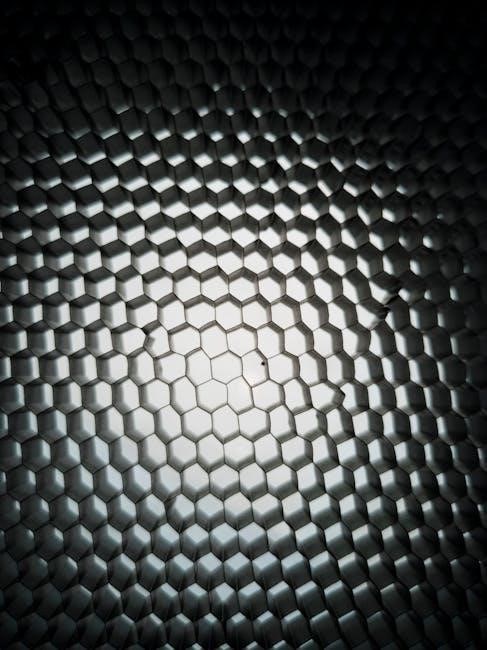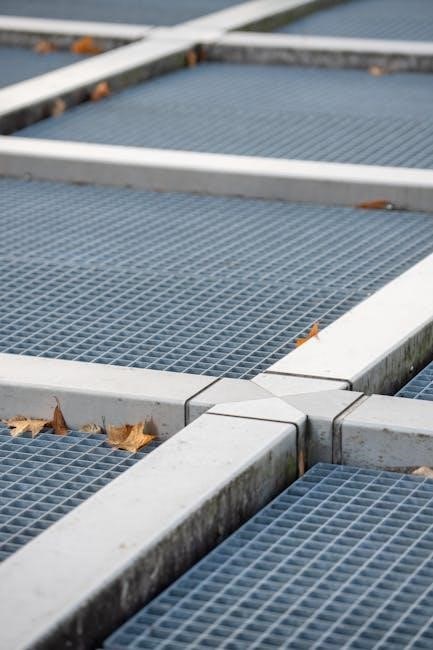The Aluminum Design Manual is an essential resource for professionals working with aluminum in structural applications, providing comprehensive specifications, design guides, and material properties for safe and efficient construction.
1.1 Overview of the Aluminum Design Manual
The Aluminum Design Manual is a comprehensive resource that provides detailed specifications, design guides, and material properties for aluminum structures. It includes sections on alloy designation systems, mechanical and physical properties, structural design considerations, and corrosion prevention. The manual also covers applications in automotive, bridge construction, and pressure vessels. It serves as a critical reference for engineers, architects, and designers, ensuring safe and efficient use of aluminum in various structural applications. The manual is regularly updated to reflect the latest advancements and industry standards.
1.2 Importance of the Aluminum Design Manual
The Aluminum Design Manual is a cornerstone for professionals in structural design, providing essential specifications and best practices for working with aluminum. It ensures safety, efficiency, and compliance with industry standards, making it indispensable for engineers, architects, and designers. The manual addresses material properties, corrosion prevention, and innovative applications, fostering confidence in aluminum’s use across industries. Its comprehensive guidance supports the advancement of aluminum in construction, transportation, and manufacturing, ensuring reliable and durable structures. This resource is vital for anyone aiming to optimize aluminum’s potential in modern engineering.
1.3 History and Evolution of the Manual
The Aluminum Design Manual has evolved significantly since its inception, with updates reflecting advancements in material science and design practices. First published by the Aluminum Association, it has undergone revisions, notably in 2010, 2015, and 2020, to incorporate new technologies and industry needs. Each edition expands on material properties, corrosion prevention, and structural applications, ensuring alignment with modern engineering challenges. The manual’s development involves collaboration between industry experts, making it a trusted resource for professionals. Its evolution underscores the growing importance of aluminum in construction and manufacturing.

1.4 Scope and Applications
The Aluminum Design Manual provides comprehensive guidance for designing aluminum structures across various industries. It covers applications in automotive, aerospace, bridge construction, rail cars, ships, and pressure vessels. The manual addresses structural components, corrosion prevention, and fire protection, ensuring safe and efficient designs. Its scope extends to sustainability and environmental considerations, making it a versatile resource for engineers, architects, and designers. By focusing on practical solutions, the manual supports innovation and durability in aluminum-based projects, catering to both traditional and emerging applications.
Material Properties of Aluminum
The manual details aluminum’s alloy and temper systems, mechanical properties, and physical characteristics, including thermal expansion and conductivity, essential for structural design and material selection.
2.1 Alloy and Temper Designation Systems
The Aluminum Design Manual provides detailed alloy and temper designation systems for wrought and cast aluminum alloys, ensuring clarity in material identification. These systems classify alloys based on their chemical composition and mechanical properties, aiding in proper material selection. The manual also includes comparative characteristics of wrought alloys and correlates foreign alloy designations with US standards. This section is crucial for understanding the properties and applications of various aluminum alloys, helping engineers and designers make informed decisions for structural and mechanical designs.

2.2 Mechanical Properties of Aluminum Alloys
The Aluminum Design Manual details the mechanical properties of aluminum alloys, including tensile strength, yield strength, and elongation. These properties are provided in both US and SI units, ensuring compatibility for global engineering standards. The manual also covers thermal expansion, electrical conductivity, and density, essential for understanding material behavior under various conditions. This section helps engineers and designers select appropriate alloys for specific applications, ensuring structural integrity and performance. The data is comprehensive, enabling precise calculations for load-bearing and dynamic systems.
2.3 Physical Properties of Aluminum
The Aluminum Design Manual provides detailed information on the physical properties of aluminum, including thermal expansion, electrical conductivity, and density. These properties are crucial for understanding how aluminum behaves under various environmental and operational conditions. The manual presents data in both US and SI units, ensuring accessibility for engineers worldwide. This section is vital for material selection, as it helps predict performance in different applications. By understanding these properties, designers can optimize aluminum’s use in structural components, ensuring efficiency and reliability.
2.4 Comparative Characteristics of Wrought Alloys
The Aluminum Design Manual provides a detailed comparison of wrought aluminum alloys, highlighting their unique properties and applications; It includes strength, corrosion resistance, and formability, helping designers select the most suitable alloy for specific projects. The manual also correlates foreign alloy designations with US standards, ensuring global compatibility. This section is invaluable for understanding the advantages and limitations of each alloy, enabling informed decisions in structural design and material selection. By comparing these characteristics, engineers can optimize aluminum’s performance in various industries.

Design Guide for Aluminum Structures
The Design Guide provides detailed insights into structural design considerations, including diaphragms, adhesive bonded joints, extrusion design, corrosion prevention, and sustainability, optimizing aluminum’s use in various applications.
3.1 Structural Design Considerations
This section outlines key principles for designing aluminum structures, focusing on member strength, stability, and durability. It addresses load calculations, material selection, and fabrication techniques to ensure safety and efficiency. Emphasis is placed on understanding aluminum’s unique properties, such as its high strength-to-weight ratio and corrosion resistance. Guidelines are provided for tension, compression, and flexural members, as well as considerations for local buckling and fatigue. Environmental factors, including corrosion prevention and fire resistance, are also covered to optimize structural performance in various applications. This section is crucial for engineers and designers working with aluminum.
3.2 Diaphragms and Adhesive Bonded Joints
This section covers the design and application of diaphragms in aluminum structures, focusing on their role in stabilizing frames and distributing loads. It also explores adhesive bonded joints, highlighting their advantages in creating strong, lightweight connections. Guidelines are provided for selecting adhesives, surface preparation, and testing bond strength. The manual emphasizes proper design practices to ensure durability and safety in various structural applications, including transportation and construction. These techniques are essential for maximizing the efficiency of aluminum in modern engineering projects.
3.3 Aluminum Composite Materials
This section explores the use of aluminum composite materials (ACMs), which combine aluminum with other materials to enhance strength, durability, and thermal performance. ACMs are widely used in structural applications for their lightweight and corrosion-resistant properties. The manual provides design guidelines for selecting and applying ACMs, including considerations for load-bearing capacities and environmental factors. It also discusses manufacturing techniques and best practices for integrating ACMs into various structures, ensuring optimal performance and longevity in applications like transportation, construction, and industrial design.
3.4 Extrusion Design and Corrosion Prevention
This section focuses on the design of aluminum extrusions, emphasizing their structural integrity and versatility. It provides guidelines for optimizing extrusion profiles to meet specific load requirements while minimizing material use. Corrosion prevention strategies are also detailed, including surface treatments, coatings, and environmental considerations. The manual highlights best practices for designing extruded components to resist corrosion in various applications, ensuring long-term durability and performance in industries such as automotive, construction, and marine engineering. These insights help engineers create efficient, corrosion-resistant aluminum structures.
3.5 Fire Protection and Sustainability
This section addresses fire protection measures for aluminum structures, focusing on material behavior at elevated temperatures and design strategies to enhance fire resistance. It also explores sustainability aspects, such as aluminum’s recyclability and energy efficiency in production. The manual provides guidance on minimizing environmental impact while maintaining structural integrity. These principles are crucial for modern engineering, ensuring safe and eco-friendly aluminum applications across various industries.

Specifications and Standards
The Aluminum Design Manual provides rules for determining the strength of aluminum structural components, including wrought, cast, and welded alloys, essential for engineers and designers.
4.1 Specification for Aluminum Structures

The Specification for Aluminum Structures provides detailed rules for determining the strength of aluminum components, including minimum strengths for wrought, cast, and welded alloys. It addresses structural design considerations, corrosion prevention, and fire protection, ensuring safe and efficient construction. This section is essential for engineers and architects, offering a comprehensive framework for designing aluminum structures in various applications, from buildings to transportation. The specifications are supported by technical commentary, providing clarity and references for professionals working with aluminum materials.
4.2 Commentary on Provisions
The Commentary on Provisions provides detailed explanations and references for the specifications outlined in the Aluminum Design Manual. It clarifies design considerations, material properties, and structural requirements, offering insights into the rationale behind the provisions. This section serves as a valuable resource for engineers and designers, ensuring a deeper understanding of the specifications and their practical applications. The commentary supports professionals in interpreting and implementing the guidelines effectively, fostering safe and efficient aluminum structure design.
4.3 Minimum Strengths for Aluminum Alloys
This section outlines the minimum strengths for various aluminum alloys, including wrought, cast, and welded materials, as well as aluminum fasteners. The manual provides essential data for determining the strength of structural components, ensuring compliance with safety and design standards. These values are presented in both US and SI units, making the manual a key resource for engineers and designers working with aluminum. The information is critical for ensuring the integrity and reliability of aluminum structures in diverse applications.
Applications of Aluminum in Structural Design
Aluminum is widely used in automotive, aerospace, bridge construction, rail cars, ships, pressure vessels, and storage tanks due to its lightweight and corrosion-resistant properties.
5.1 Aluminum in Automotive Structures
Aluminum is increasingly used in automotive structures due to its lightweight, corrosion resistance, and high strength-to-weight ratio. It is employed in body frames, engine components, and exterior panels to enhance fuel efficiency and reduce emissions. The Aluminum Design Manual provides design references for automotive applications, addressing tension members, compression members, and flexural members. It also covers fatigue considerations and connections, ensuring safe and efficient vehicle design. Aluminum’s adaptability makes it a key material in modern automotive engineering, supporting sustainability and performance goals.
5.2 Aluminum in Bridge Construction
Aluminum is gaining traction in bridge construction due to its corrosion resistance, lightweight, and durability. It is used in bridge decks, structural components, and railings, reducing maintenance costs and extending lifespan. The Aluminum Design Manual provides design references for bridge applications, focusing on structural integrity, fatigue resistance, and corrosion prevention. Aluminum’s high strength-to-weight ratio and adaptability make it ideal for long-span bridges and harsh environments, supporting sustainable and innovative infrastructure solutions while ensuring safety and performance.
5.3 Aluminum in Rail Cars and Ships
Aluminum is widely used in rail cars and ships due to its lightweight, corrosion resistance, and high strength-to-weight ratio. In rail cars, aluminum reduces weight, improving fuel efficiency and payload capacity. For ships, its corrosion resistance in marine environments extends service life. The Aluminum Design Manual provides design references for these applications, addressing structural components, marine hardware, and fatigue resistance. Aluminum’s durability and adaptability make it ideal for both rail and marine industries, ensuring safety, efficiency, and reduced maintenance over time.
5.4 Aluminum in Pressure Vessels and Storage Tanks
Aluminum is increasingly used in pressure vessels and storage tanks due to its high strength-to-weight ratio, corrosion resistance, and weldability. Its durability in harsh environments makes it ideal for storing liquids and gases. The Aluminum Design Manual provides design references for these applications, ensuring safety and efficiency. Aluminum’s lightweight and resistance to corrosion reduce maintenance costs and extend service life, making it a preferred material for both industrial and marine storage solutions.
Fabrication and Manufacturing Processes
The Aluminum Design Manual details fabrication techniques, including cutting, forming, and joining methods, ensuring high-quality aluminum structures through precise manufacturing and corrosion prevention strategies.
6.1 Common Fabrication Techniques
The Aluminum Design Manual outlines various fabrication methods for aluminum, including cutting, forming, and joining processes. Cutting techniques involve sawing, shearing, or machining, while forming includes bending, rolling, and extruding. Joining methods such as welding, mechanical fastening, and adhesive bonding are detailed to ensure structural integrity; These techniques are essential for producing high-quality aluminum components, emphasizing precision and durability in manufacturing. The manual also addresses corrosion prevention and surface preparation to maintain material performance. Proper fabrication ensures aluminum structures meet design specifications and safety standards.
6.2 Welding and Its Effects on Member Strength
Welding is a critical process in aluminum fabrication, but it can significantly affect member strength. The Aluminum Design Manual details how welding alters mechanical properties, reducing strength due to heat-affected zones. Techniques like MIG and TIG welding are commonly used, but improper methods can lead to defects. The manual emphasizes post-weld treatments to restore strength and durability. Understanding these effects is crucial for ensuring structural integrity in aluminum constructions, particularly in load-bearing applications. Proper welding practices are essential to maintain safety and performance standards.
6.3 Corrosion Prevention Methods

Corrosion prevention is vital for maintaining the durability and integrity of aluminum structures. The Aluminum Design Manual outlines various methods, including surface treatments like anodizing and chromate conversion coatings. Protective coatings, such as paint and lacquer, are also recommended to shield aluminum from environmental factors. Design considerations, like avoiding crevices and ensuring proper drainage, are emphasized to prevent moisture accumulation. Additionally, cathodic protection and the use of corrosion-resistant alloys are discussed as effective strategies. These methods ensure long-term performance and safety in diverse applications.
6.4 Fire Protection Measures
The Aluminum Design Manual provides detailed fire protection measures to ensure the safety and durability of aluminum structures. It emphasizes the use of fire-resistant coatings and insulation to mitigate the effects of high temperatures. Design considerations include material selection and structural integrity to maintain performance under fire conditions. The manual also addresses passive fire protection systems and their application in various structures. These guidelines help engineers and architects design aluminum structures that meet fire safety standards, ensuring both occupant safety and structural resilience.
6.5 Environmental Considerations
The Aluminum Design Manual emphasizes sustainable practices and environmental considerations in aluminum fabrication. It highlights the importance of recycling and reusing aluminum to reduce material waste and energy consumption. The manual provides guidelines for minimizing environmental impact through efficient manufacturing processes and sustainable design. It also addresses the use of environmental product declarations (EPDs) to assess the ecological footprint of aluminum products. These considerations ensure that aluminum structures are not only durable but also environmentally responsible, aligning with modern sustainability goals and reducing long-term environmental effects.

Joints and Connections in Aluminum Structures
The Aluminum Design Manual details various joints and connections, including welded, bolted, and adhesive bonded, addressing design considerations and the impact of welding on strength.
7.1 Types of Joints and Connections
The Aluminum Design Manual outlines various types of joints and connections, including welded, bolted, pinned, screwed, and adhesive bonded joints. Each type is detailed with specific design considerations, such as load transfer, durability, and resistance to environmental factors. Welded connections are emphasized for their strength and efficiency, while bolted and pinned joints offer flexibility and ease of assembly. Screwed connections are suitable for thinner materials, and adhesive bonded joints provide exceptional resistance to fatigue and corrosion. The manual ensures proper selection and execution of these connections for optimal structural integrity.
7.2 Welded Connections
Welded connections are a popular choice for aluminum structures due to their strength and efficiency. The Aluminum Design Manual provides detailed guidance on welding techniques, joint design, and filler metal selection. It emphasizes proper pre-weld and post-weld treatments to maintain material integrity. Factors such as heat input, shielding gases, and distortion control are addressed to ensure high-quality welds. The manual also discusses the effects of welding on member strength and fatigue resistance, offering recommendations to mitigate these impacts. Properly executed welded connections are critical for achieving durable and reliable aluminum structures.
7.3 Bolted and Pinned Connections
Bolted and pinned connections are widely used in aluminum structures for their simplicity and reliability. The Aluminum Design Manual provides detailed design considerations, including clamping forces, hole tolerances, and surface preparation. It addresses the selection of fasteners, such as bolts and pins, and their compatibility with aluminum alloys. The manual also covers factors influencing connection strength, like friction, bearing, and shear resistance. Proper installation techniques and corrosion prevention methods are emphasized to ensure long-term performance. These connections are critical for transferring loads efficiently in aluminum structures while maintaining structural integrity.
7.4 Screwed Connections
Screwed connections are commonly used in aluminum structures for their ease of installation and adaptability. The Aluminum Design Manual provides guidelines for designing screwed connections, emphasizing proper thread engagement and torque control to ensure structural integrity. It addresses material compatibility, as aluminum’s properties can influence screw performance. The manual also covers load transfer mechanisms, such as friction and bearing resistance, and provides best practices for installation to prevent issues like loosening or corrosion. These connections are particularly useful in applications requiring disassembly or adjustment, offering reliable performance when designed correctly.
7.5 Adhesive Bonded Joints
Adhesive bonded joints are increasingly used in aluminum structures for their ability to distribute stress evenly and minimize weight. The Aluminum Design Manual provides detailed guidance on designing and implementing these joints, emphasizing proper surface preparation and adhesive selection. It addresses the importance of material compatibility and environmental factors, such as temperature and humidity, which can affect bond durability. The manual also includes best practices for inspection and testing to ensure long-term reliability. Adhesive bonding is particularly advantageous in applications like lightweight vehicles and composite materials, offering a strong, corrosion-resistant alternative to traditional fastening methods.

Load and Resistance Factor Design (LRFD)
The Aluminum Design Manual introduces LRFD as a reliability-based design approach, ensuring aluminum structures meet safety and performance requirements through precise load and resistance calculations.
8.1 LRFD Philosophy
The LRFD philosophy in the Aluminum Design Manual is a reliability-based design approach that ensures aluminum structures meet safety and performance requirements. It uses load and resistance factors to account for uncertainties in material properties, loads, and fabrication. By applying probabilistic methods, LRFD provides a balanced approach to design, ensuring structures are both safe and efficient. This philosophy is central to modern aluminum design, enabling engineers to optimize structural integrity while adhering to specified safety margins. It is widely adopted for its ability to handle the unique properties of aluminum alloys in various applications.
8.2 Design Examples Using LRFD
The Aluminum Design Manual provides practical examples demonstrating the application of LRFD principles in aluminum structural design. These examples include the design of tension members, compression members, and flexural members, as well as connections such as bolted, welded, and screwed joints. The manual also addresses fatigue considerations and the effects of welding on member strength. By following these examples, engineers can better understand how to apply LRFD to ensure safe and efficient aluminum designs, adhering to the specified load and resistance factors. This section serves as a valuable resource for real-world applications.
Fatigue and Fracture Mechanics
This section provides in-depth analysis of fatigue and fracture mechanics in aluminum structures, emphasizing their impact on structural integrity and long-term performance under cyclic loading conditions.
9.1 Fatigue Design Considerations
Fatigue design is critical for aluminum structures subjected to cyclic loading, ensuring long-term reliability. Key considerations include stress analysis, material selection, and minimizing stress concentrations. The Aluminum Design Manual provides guidelines for assessing fatigue life, including S-N curves and environmental factors. Designers must account for variable amplitude loading and corrosion effects, which can accelerate fatigue. Proper alloy selection and surface treatments are essential to enhance resistance. Adherence to these principles ensures structural integrity and safety in applications prone to repetitive stress, such as transportation and machinery.
9.2 Fracture Mechanics in Aluminum Structures
Fracture mechanics in aluminum structures focuses on understanding and predicting crack growth under various loads. The Aluminum Design Manual provides guidelines for assessing fracture risk, emphasizing material toughness and stress intensity factors. Key considerations include crack initiation, propagation, and arrest, influenced by factors like alloy type, temperature, and environmental conditions. Designers use linear elastic fracture mechanics (LEFM) to evaluate critical crack sizes and ensure structural integrity. The manual also addresses methods to mitigate fracture risks through proper material selection and design detailing, ensuring reliable performance in critical applications.
9.3 Case Studies on Fatigue and Fracture
The Aluminum Design Manual includes case studies that illustrate real-world fatigue and fracture scenarios in aluminum structures. These studies highlight how material properties, design flaws, and environmental factors contribute to failure. Examples from aerospace, automotive, and construction industries demonstrate the importance of proper material selection and design practices. By analyzing these cases, engineers can identify patterns and develop strategies to mitigate fatigue and fracture risks, ensuring safer and more durable aluminum structures. These practical insights are invaluable for improving design reliability and performance.
The Aluminum Design Manual is a comprehensive guide advancing aluminum applications, ensuring safety, efficiency, and sustainability in structural design while addressing future trends and innovations effectively.

10.1 Summary of Key Points
The Aluminum Design Manual provides comprehensive guidelines for designing aluminum structures, covering material properties, fabrication techniques, and structural applications. It emphasizes corrosion prevention, sustainability, and fire protection, ensuring safe and efficient construction. The manual is tailored for engineers, architects, and designers, offering detailed specifications and design examples. By addressing fatigue, fracture mechanics, and load resistance, it ensures durability and reliability in various applications, from automotive to marine industries. This resource remains indispensable for advancing aluminum’s role in modern engineering and sustainable development.
10.2 Future Trends in Aluminum Design
Future trends in aluminum design emphasize sustainability, circular recycling, and advanced material science. The industry is moving toward eco-friendly practices, reducing environmental impact through improved recycling methods and energy-efficient production. Innovations in alloy development and fabrication techniques are expected to enhance strength and durability. Digital tools and AI-driven design software will play a larger role in optimizing structures. The integration of aluminum in renewable energy systems and smart buildings is anticipated to grow, aligning with global sustainability goals and advancing the material’s versatility in modern engineering applications;
